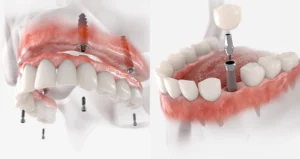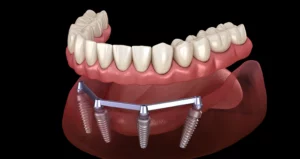When it comes to restoring a confident smile and functional bite, dental implants have revolutionized modern dentistry. Among the various implant options available, two popular choices often come into comparison: All on 4 vs Traditional Implants. Understanding the differences, benefits, and considerations between these two approaches is important for making informed decisions about dental restoration procedures.
Let us explore the key differences, benefits, and considerations of All-on-4 implants versus traditional implants to help you determine which option is best for you.
All-on-4 vs Traditional Implants
Before comparing All-on-4 implants with Traditional implants, let us first explain what they are and what role they play.
Traditional Implants:
Traditional dental implants involve a surgical procedure where a titanium post is inserted into your jawbone, acting like a tooth root. Over several weeks, this post bonds with your bone during the healing process. Once healed, a connector piece called an abutment and a crown are attached to the implant, creating a replacement tooth that not only functions well but also looks natural.
For traditional implants to work, your jawbone needs to be strong and healthy. If your jawbone isn’t strong enough, traditional implants might not be suitable without additional help. In such cases, a bone graft may be needed. This procedure involves adding bone material from another part of your body to your jawbone, strengthening it for the implant.
All on 4 Implants:
All-on-4 dental implants, another facet of the All-on-4 vs Traditional Implants discussion. All-on-4 dental implants offer a groundbreaking solution compared to traditional dentures. They involve strategically placing four to six implants to support an entire set of new teeth. What sets All-on-4 apart is the angle of the posterior implants, tilted at 45 degrees. This angle is particularly beneficial for those with jawbone loss, often eliminating the need for additional bone grafting procedures. For individuals in need of full dentures, All-on-4 stands out as the preferred choice for addressing tooth loss.
One of the significant benefits of All-on-4 implants is their cost-effectiveness compared to traditional implant treatments. Additionally, they require a shorter healing period due to the fact that fewer implants are needed. This efficient process is sometimes referred to as ‘Teeth in a Day’ because it enables patients to receive durable temporary dentures immediately after the implant procedure, providing functional teeth right away.
How Traditional Dental Implants Work?
Traditional dental implants work by placing a single titanium post into your jawbone through surgery. With time, your bone grows near the implant, merging with the post to form a sturdy base for replacement teeth. After the healing period, an abutment is attached to link the implant post with a custom-made crown, bridge, or denture.

However, if you need multiple implants, the process can be longer and more costly than All-on-4 dental implants. Each implant necessitates its own surgical procedure, healing time, and restoration, adding to the overall treatment duration and expenses.
How All-on-4 Dental Implants Work?
All-on-4 dental implants involve strategically placing four or more posts into your jawbone, which are then connected to an acrylic bridge. Unlike traditional implants, you don’t have to wait for days for the implant to fuse with the bone before getting replacement teeth. You’ll receive temporary teeth on the same day as the implant procedure. Your final, permanent teeth will be crafted and placed 3-4 months after the surgery.
All-on-4 vs Traditional Implants: Key Differences
Aspect | All-on-4 Implants | Traditional Implants |
Number of Implants | Utilizes four implants strategically placed per arch, reducing surgical complexity and time. | It involves the placement of six or more implants per arch, potentially requiring more surgical steps. |
Bone Density Needs | Designed to work well with moderate bone loss and eliminate the need for extensive bone grafting. | Bone grafting procedures may be required for patients with significant bone loss to ensure implant stability. |
Procedure Complexity | Requires only four implants per arch, reducing surgical complexity, time in the chair, and overall treatment duration. | It Involves placing six or more implants per arch, potentially requiring additional surgical procedures such as bone grafting and sinus lifts, leading to a longer treatment timeline. |
Cost Considerations | Initial costs may be higher per arch compared to traditional implants, but savings can be realized over time due to reduced surgical complexity and fewer additional procedures. | Costs vary depending on the number of implants, bone grafting needs, and additional procedures required. |
Long-Term Stability | When properly planned and maintained, All-on-4 implants can provide stable and successful long-term outcomes, especially for patients with compromised bone structure. | Traditional implants also have high success rates but may require additional implants or support in complex cases. |
Conclusion
Choosing between All-on-4 vs Traditional Implants is an important decision that depends on various factors such as oral health, bone density, budget, and desired outcomes. Consulting with your dental provider for a comprehensive evaluation and personalized recommendation is crucial for achieving optimal results in the All-on-4 vs Traditional Implants dilemma.
Ready to explore which dental implant option suits you best? Book an appointment online with Tamarack Hills Family Dentistry in Woodbury, MN, today! New patients can call us at (651) 432-0975, while current patients can reach us at (651) 964-3747.
fAQ
How do All-on-4 vs traditional implants differ?
All-on-implants use fewer implants to support an entire arch of teeth, while Traditional Implants replace individual missing teeth with separate implants.
All-on-4 vs Traditional Implants: Which option is more cost-effective,?
All-on-4 implants are generally more cost-effective due to requiring fewer implants and shorter treatment duration.
Are All-on 4-implants suitable for everyone?
While All-on-4 implants offer many benefits, not every patient is a suitable candidate. Factors such as bone density and your overall oral health play a role in candidacy.



